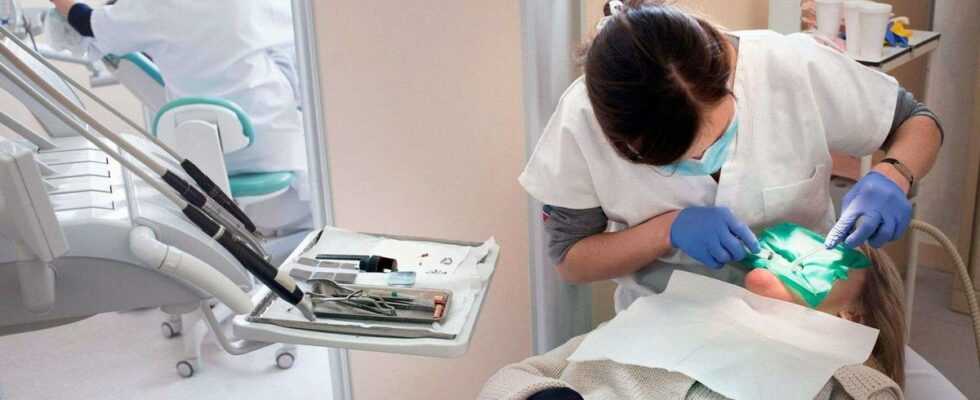One of the unexpected effects of Covid: the boom in adult orthodontics. Like Coralie, in her forties employed in a large company in the region, who decided in the midst of a pandemic to put on her dental braces. “The use of videoconferencing was revealing. All day, you take the gap between your incisors in the face. We had to react. “And she is not the only one to feel the need to be treated if we are to believe the survey carried out by Harris Interactive, 39% of the French people questioned wear or have worn a device, while …
One of the unexpected effects of Covid: the boom in adult orthodontics. Like Coralie, in her forties employed in a large company in the region, who decided in the midst of a pandemic to put on her dental braces. “The use of videoconferencing was revealing. All day, you take the gap between your incisors in the face. We had to react. “And she is not the only one to feel the need to be treated if we are to believe the survey carried out by Harris Interactive, 39% of French people questioned wear or have worn a device, while 16% believe that they would need it. By the way, the period is propitious: under the mask, the metallic smile is more discreet than ever…
It must also be said that orthodontics has made undeniable progress: treatments are increasingly light, such as rings placed inside the mouth, or even completely invisible. “Thanks to 3D, they are also more precise”, emphasizes Dr Jean-Baptiste Kerbrat, maxillofacial surgeon, stomatologist at Pitié Salpêtrière and member of the French Federation of Orthodontists. For him, there is above all a real “social progress”: “In France, universal coverage allows access to orthodontics for all children under 16, free of charge for low-income families. It is a chance. As a result, in college and high school classes, few students do not wear hearing aids. The figures from the Federation are eloquent: each year, some 900,000 young people are cared for by one of the 2,200 specialized orthodontists, for a period fluctuating between one and three years of treatment.
Since 1988, the amount of reimbursements has been set at a maximum of 193.50 euros over six semesters.
French Federation of Orthodontics
An investment
But for most families, “the rest is important”. In fact: “Social Security has not reassessed its care rates for 40 years,” notes Dr. Kerbrat. Since 1988, the amount of reimbursements has been set at a maximum of 193.50 euros over six semesters. As for mutuals, beware of the discourse: “A 100% reimbursement (of the moderating ticket) is a decoy because it means that it will not exceed the coverage of Social Security. For this specialist, a good mutual must cover orthodontic care at least up to 250%. Which is rarely the case. Thus, the bill for a smile quickly turns into a grimace, especially for adults: “In addition, for them, surgery is often necessary, to have an action on the jaws. »
In short, it is an investment. It’s so true that “statistical studies have proven that adults with aligned teeth have better incomes,” says the doctor. “There is real social pressure,” he says.
Aesthetics or health?
On this account, is it about aesthetics or health? “There is a real medical necessity to align the teeth,” retorts the specialist. “Otherwise, Social Security would not follow. Jaw or teeth problems cause functional problems, they have an influence on breathing, swallowing, chewing, phonation. They can also induce sleep apnea. “For example, a child who has a too narrow jaw will breathe through his mouth, his palate will not develop well, and there will be no room for the teeth: it’s a vicious circle. With the treatment, the teeth will straighten but this is only a consequence. Be careful not to focus on the symptoms (the misalignment) without worrying about the causes. The alignment of the teeth alone is meaningless. And if patients are primarily motivated by aesthetic concerns, they quickly understand the medical issue.
“Jaw or teeth problems cause functional problems, they have an influence on breathing, swallowing, chewing, phonation”
But how far should we go? “A mini defect in adolescence must be taken into account: it will increase over time. Which is not necessarily true for adults. “If the detail remains stable for two or three years, there is no need to intervene. On the other hand, the pitfalls are not lacking. For Dr. Kerbrat, one rule: “The sooner the child is taken care of, in particular to correct the jaws, the lighter the treatment will be. On the other hand, know this: no treatment is definitive, teeth continue to evolve throughout life.
Orthodontics still has a bright future ahead of it. His challenge? Evolve “while remaining in control of the trade, independent from hardware companies”. Right in his blouse.

